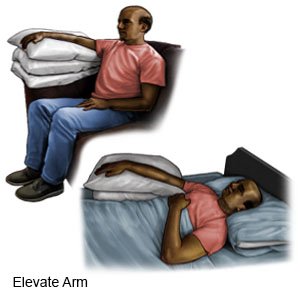Finger Sprain
Medically reviewed by Drugs.com. Last updated on Aug 4, 2025.
A finger sprain happens when ligaments in your finger or thumb are stretched or torn. Ligaments are the tough tissues that connect bones. Ligaments allow your hands to grasp and pinch.
DISCHARGE INSTRUCTIONS:
Return to the emergency department if:
- The skin on your injured finger looks bluish or pale (less color than normal).
- You have new weakness or numbness in your finger or thumb. It may tingle or burn.
- You have a splint that you cannot adjust and it feels too tight.
Call your doctor if:
- You have new or increased swelling or pain in your finger.
- You have new or increased stiffness when you move your injured finger.
- You have questions or concerns about your injury or treatment.
Medicines:
- Prescription pain medicine may be given. Ask your healthcare provider how to take this medicine safely. Some prescription pain medicines contain acetaminophen. Do not take other medicines that contain acetaminophen without talking to your healthcare provider. Too much acetaminophen may cause liver damage. Prescription pain medicine may cause constipation. Ask your healthcare provider how to prevent or treat constipation.
- Take your medicine as directed. Contact your healthcare provider if you think your medicine is not helping or if you have side effects. Tell your provider if you are allergic to any medicine. Keep a list of the medicines, vitamins, and herbs you take. Include the amounts, and when and why you take them. Bring the list or the pill bottles to follow-up visits. Carry your medicine list with you in case of an emergency.
Care for your finger:
- Rest your finger for at least 48 hours. Do not do activities that cause pain. Return to normal activities as directed.
- Apply ice on your finger to help decrease pain and swelling. Use an ice pack, or put crushed ice in a plastic bag. Cover the bag with a towel before you place it on your finger. Apply ice every hour for 15 to 20 minutes at a time. You may need to apply ice at least 4 to 8 times each day. Continue for as many days as directed.
- Elevate (raise) your finger above the level of your heart as often as you can. This will help decrease swelling and pain. You can elevate your hand by resting it on a pillow.

- Use a splint or compression as directed. Compression (tight hold) helps support your finger or thumb as it heals. Tape your injured finger to the finger beside it. Severe sprains may be treated with a splint. A splint prevents your finger from moving while it heals. Ask how long you must wear the splint or tape, and how to apply them.
- Do exercises as directed. You may be given gentle exercises to begin in a few days. Exercises can help decrease stiffness in your finger or thumb. Exercises also help decrease pain and swelling and improve the movement of your finger or thumb. Check with your healthcare provider before you return to your normal activities or sports.
Follow up with your doctor as directed:
Write down any questions you may have to ask at your follow up visits.
© Copyright Merative 2025 Information is for End User's use only and may not be sold, redistributed or otherwise used for commercial purposes.
The above information is an educational aid only. It is not intended as medical advice for individual conditions or treatments. Talk to your doctor, nurse or pharmacist before following any medical regimen to see if it is safe and effective for you.
Learn more about Finger Sprain
Care guides
Further information
Always consult your healthcare provider to ensure the information displayed on this page applies to your personal circumstances.
